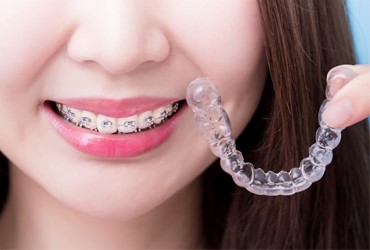Invisalign vs. Braces: Which Is the Better Option?

Braces and clear aligners such as Invisalign are orthodontic treatments used to treat malocclusion (crowded, protruding, or crooked teeth) to improve the look and feel of your smile. Both teeth-straightening methods work by exerting pressure to realign the teeth and jaw and correct a malocclusion, sometimes called a "bad bite.
Traditional braces typically consist of brackets attached to a wire and fitted to your teeth. Clear removable aligners, such as Invisalign, were created more recently to address some of the problems associated with traditional braces.
Comparing Invisalign vs. Braces
Invisalign and braces work similarly to correct problems with the alignment and spacing of your teeth. Take a look at the differences between these orthodontic devices in terms of price, aesthetics, comfort, effectiveness, speed, and more.
Invisalign Price
The cost of orthodontic treatments depends on many factors. On average, braces cost about $3,000–$7,000 in the United States.3 Invisalign may be comparable or a little more. These costs may vary based on your location, the duration of your treatment, the complexity of your dental concerns, and the orthodontist you choose.
Some dental insurance plans may cover a certain percentage of orthodontic treatments, especially for children and teens. Braces are somewhat more likely to be covered than Invisalign.4
Many dentists and orthodontists offer financing and flexible payment plans to make teeth straightening treatments more affordable.5 You can also consider third-party healthcare financing options.
Aesthetics with Invisalign
Many people, especially adults, opt for Invisalign because of its natural aesthetic appearance. Plastic aligners like Invisalign look like clear retainers and are custom-made to fit your mouth. The trays are virtually unnoticeable, even from short distances away.
Braces usually consist of small brackets that are attached to a wire and fitted with bands. The brackets may be made out of metal, ceramic, plaster, or other materials. They may be clear, silver, the color of your teeth, or a variety of other colors.6 Lingual braces are a type of brace attached to the back of your teeth to make them less obvious.
Comfort with Invisalign
Research suggests that people with traditional braces experience more pain and discomfort than those using Invisalign, especially in the early weeks of treatment and each time an orthodontist tightens them.
Clear aligners like Invisalign may also take some time to get used to. Patients may have excessive salivation and speak with a lisp for the first few days after beginning treatment.
Braces may also be uncomfortable when metal scrapes or pushes up against the inside of your mouth. Invisalign has a smoother, softer feel.
Effectiveness and Speed of treatment with invisalign vs Braces
Both Invisalign and braces are approved by the Food and Drug Administration (FDA) for the orthodontic treatment of malocclusion.
Invisalign is typically used to treat mild to moderate dental concerns. Braces are often preferable and more effective in more complex cases, such as rotated teeth, large gaps, or severe crowding.
People typically wear Invisalign for 12 to 18 months, but some people may only need them for six to 10 months. By contrast, fixed braces often take one to two years to work. The length of time depends on many individual factors, so talk to your Dentist about what to expect for your case.
Eating with Invisalign
One of the advantages of clear aligners like Invisalign is that they’re removable. You can (and should) take them out when you’re eating or drinking. Just remember to brush and floss before you put them back in to avoid tooth decay.
If you have braces, you’ll have to avoid certain foods that can stick to or damage the brackets. Steer clear of hard foods, like apples, pears, carrots, popcorn, and nuts, as well as sticky foods, like chewy candy and gum.
Care and Cleaning with Invisalign
To avoid tooth decay, you should brush your teeth after every meal or snack and floss daily if you wear braces. Use an interdental brush (a tiny brush that goes between the teeth) to get into all the crevices.
Research suggests that people who straighten their teeth with clear aligners experience fewer cavities, less tooth decay, and have fewer gum problems than people who wear braces. To prevent bacteria and calcium buildup, wash your aligner with Invisalign’s cleaning solution after each meal.11
Braces Procedure
To get traditional braces, you’ll start with a thorough dental examination and X-ray imaging. Your orthodontist will secure the brackets to your teeth with bonding adhesive, thread a wire through them, and keep the wire and brackets firmly in place with a series of bands.12
Traditional braces may involve more follow-up visits to the orthodontist over time for tightening and adjustments. After your braces are removed, you might also have to wear a retainer for one to three years to maintain your results.
Invisalign Procedure
Getting fitted for Invisalign starts with a process of including a dental examination and imaging. Then, your dentist will make a mold of your teeth to create a series of custom-fit aligner trays. They may be temporarily fitted to your teeth with small attachments. You’ll switch to another set of aligners every one to three weeks to gradually realign your teeth.
It’s important to wear Invisalign at least 22 hours per day in order to see results. If you frequently forget to put your aligners back on, they won’t be effective.